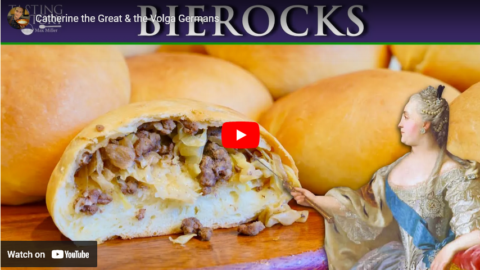Tasting History with Max Miller
Published 16 Aug 2022
Support the Channel with Patreon ► https://www.patreon.com/tastinghistory
Merch ► crowdmade.com/collections/tastinghistory
Instagram ► https://www.instagram.com/tastinghist…
Twitter ► https://twitter.com/TastingHistory1
Tiktok ► TastingHistory
Reddit ► https://www.reddit.com/r/TastingHistory/
Discord ► https://discord.gg/d7nbEpy
Amazon Wish List ► https://amzn.to/3i0mwGtSend mail to:
Tasting History
22647 Ventura Blvd, Suite 323
Los Angeles, CA 91364RECIPE
For the dough:
1 ½ teaspoons Active Dry Yeast
1/4 cup (60ml) warm water
6 cups (720g) Flour
2/3 cup (135g) Sugar
1 ½ teaspoons Salt
1 ½ cups (350ml) Milk
10 tablespoons (140g) Butter cut up and at room temperature
2 Eggs, lightly beatenFor the filling:
2-3 tablespoons oil for frying
1 large Yellow Onion, diced
1 pound (450g) lean ground beef
1/2 cup (150) sauerkraut drained
1 large head of Cabbage, shredded
1 teaspoon crushed caraway seeds
Salt and Pepper to taste
2-4 tablespoons Dijon mustard1. Heat the milk to 180°F then remove it from the heat and whisk in the butter. Let the mixture cool to 120°F.
2. Activate the yeast by mixing it with 1/4 cup warm water and a pinch of sugar.
3. Whisk the flour, sugar, and salt together, then add the yeast, eggs, and milk/butter mixture. Form a dough and knead until smooth, adding flour when necessary to make it workable. It should still remain a sticky dough. Put the dough into a lightly greased bowl and cover, letting it rise for 1 hour or until doubled in size. Then punch down the dough and let it rise a second time.
4. While the dough rises, heat the oil in a large frying pan and add the yellow onion. Cook for 10 minutes or until the onions are soft and translucent. Then add the ground beef and cook until browned, about 7 minutes. Add the cabbage and let it cook down for a couple minutes, then add the rest of the ingredients and cook for several minutes, tasting and adjusting spice as it cooks. Once cooked, set the filling aside to cool completely.
5. Once the dough is fully risen, divide it into 15 equal pieces and form them into balls. Roll each ball out into a circle 6 inches in diameter. Place 1/3 cup of cooled filling into the center of each disk of dough and gather up the sides to form a parcel, pinching the dough together in the center.
6. Set the bierocks on a lightly greased baking sheet, leaving 1 inch between each, then cover and let rise for 20 minutes.
7. Once risen, bake the bierocks, 1 sheet at a time, in the oven at 350°F for 15 – 20 minutes, or until the tops begin to brown. Remove them from the oven and brush with melted butter. Serve warm or at room temperature.**Some of the links and other products that appear on this video are from companies which Tasting History will earn an affiliate commission or referral bonus. Each purchase made from these links will help to support this channel with no additional cost to you. The content in this video is accurate as of the posting date. Some of the offers mentioned may no longer be available.
Subtitles: Jose Mendoza | IG @worldagainstjose
PHOTO CREDITS
The throne at the Winter Palace: By Dr Vikramjit Kakati – Own work, CC BY-SA 4.0, https://commons.wikimedia.org/w/index…
Pirog: Tatyana Smetanina ; processed by Off-shell, CC BY 3.0 https://creativecommons.org/licenses/…, via Wikimedia Commons
Pirozhki: Polina Tankilevitch via Pexels
Börek: O.celebi, CC BY-SA 4.0 https://creativecommons.org/licenses/…, via Wikimedia Commons
Runza Restaurant in Gering, Nebraska: By Egpetersen – Own work, CC BY-SA 4.0, https://commons.wikimedia.org/w/index…#tastinghistory #germancuisine #catherinethegreat
January 10, 2023
Catherine the Great & the Volga Germans
Comments Off on Catherine the Great & the Volga Germans
No Comments
No comments yet.
RSS feed for comments on this post.
Sorry, the comment form is closed at this time.




